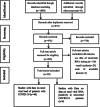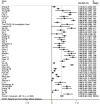The importance of fecal nucleic acid detection in patients with coronavirus disease (COVID-19): A systematic review and meta-analysis
- PMID: 35174515
- PMCID: PMC9088624
- DOI: 10.1002/jmv.27652
The importance of fecal nucleic acid detection in patients with coronavirus disease (COVID-19): A systematic review and meta-analysis
Abstract
Pooled data from 2352 hospitalized coronavirus disease 2019 (COVID-19) patients with viral RNA in feces across 46 studies were analyzed and the pooled prevalence of fecal RNA was 46.8% (95% confidence interval [CI]: 0.383-0.554). The pooled analysis showed that the occurrence of total gastrointestinal (GI) symptoms was 28.5% (95% CI: 0.125-0.44) in COVID-19 patients with fecal RNA, that of both respiratory and GI symptoms was 21.9% (95% CI: 0.09-0.346), that of only GI symptoms was 19.8% (95% CI: 0.107-0.288), and that of only respiratory symptoms was 50.5%(95% CI: 0.267-0.744). The pooled data showed no significant difference in positive fecal RNA between severe and nonsevere cases (odds ratio = 2.009, p = 0.079, 95% CI: 0.922-4.378). During hospital admission, after samples from the respiratory system tested negative for viral RNA, 55.4% (95% CI: 0.418-0.669) of the patients with positive fecal RNA had persistent shedding of fecal RNA and pooled results from the other 4 studies including 848 discharged patients with nucleic acid-negative stool samples indicated that the occurrence of repositive stool swabs was 18.1% (95% CI: 0.028-0.335), that of repositive respiratory swabs was 22.8% (95% CI: 0.003-0.452), that of both repositive stool and respiratory swabs was 19.1% (95% CI: 0.019-0.363), and that of only repositive stool swabs was 9.6% (95% CI: 0.010-0.203). The digestive tract may be an important organ involved in COVID-19 infection and in the excretion of the virus. Because of the potential risk of fecal-oral transmission, giving emphasis on stool swab tests can help increase the detection rate of asymptomatic carriers and reduce missed diagnoses.
Keywords: COVID-19; fecal; meta-analysis; systematic review.
© 2022 Wiley Periodicals LLC.
Conflict of interest statement
The authors declare no conflicts of interest.
Figures



Similar articles
-
Prevalence and Persistent Shedding of Fecal SARS-CoV-2 RNA in Patients With COVID-19 Infection: A Systematic Review and Meta-analysis.Clin Transl Gastroenterol. 2021 Apr 9;12(4):e00343. doi: 10.14309/ctg.0000000000000343. Clin Transl Gastroenterol. 2021. PMID: 33835096 Free PMC article.
-
Detection of SARS-CoV-2 in Fecal Samples From Patients With Asymptomatic and Mild COVID-19 in Korea.Clin Gastroenterol Hepatol. 2021 Jul;19(7):1387-1394.e2. doi: 10.1016/j.cgh.2020.06.005. Epub 2020 Jun 10. Clin Gastroenterol Hepatol. 2021. PMID: 32534042 Free PMC article.
-
Gastrointestinal symptoms and fecal nucleic acid testing of children with 2019 coronavirus disease: a systematic review and meta-analysis.Sci Rep. 2020 Oct 20;10(1):17846. doi: 10.1038/s41598-020-74913-0. Sci Rep. 2020. PMID: 33082472 Free PMC article.
-
Gastrointestinal symptoms and fecal shedding of SARS-CoV-2 RNA suggest prolonged gastrointestinal infection.Med. 2022 Jun 10;3(6):371-387.e9. doi: 10.1016/j.medj.2022.04.001. Epub 2022 Apr 13. Med. 2022. PMID: 35434682 Free PMC article.
-
Persistence and clearance of viral RNA in 2019 novel coronavirus disease rehabilitation patients.Chin Med J (Engl). 2020 May 5;133(9):1039-1043. doi: 10.1097/CM9.0000000000000774. Chin Med J (Engl). 2020. PMID: 32118639 Free PMC article.
Cited by
-
Food and Environmental Virology: Use of Passive Sampling to Characterize the Presence of SARS-CoV-2 and Other Viruses in Wastewater.Food Environ Virol. 2024 Mar;16(1):25-37. doi: 10.1007/s12560-023-09572-1. Epub 2023 Dec 20. Food Environ Virol. 2024. PMID: 38117471 Free PMC article.
-
Long-term alterations in gut microbiota following mild COVID-19 recovery: bacterial and fungal community shifts.Front Cell Infect Microbiol. 2025 May 26;15:1565887. doi: 10.3389/fcimb.2025.1565887. eCollection 2025. Front Cell Infect Microbiol. 2025. PMID: 40491436 Free PMC article.
-
A large series of molecular and serological specimens to evaluate mother-to-child SARS-CoV-2 transmission: a prospective study from the Italian Obstetric Surveillance System.Int J Infect Dis. 2023 Jan;126:1-9. doi: 10.1016/j.ijid.2022.10.045. Epub 2022 Nov 8. Int J Infect Dis. 2023. PMID: 36368605 Free PMC article.
-
Characteristics of COVID-19 Patients With SARS-CoV-2 Positivity in Feces.Front Cell Infect Microbiol. 2022 Apr 12;12:853212. doi: 10.3389/fcimb.2022.853212. eCollection 2022. Front Cell Infect Microbiol. 2022. PMID: 35493744 Free PMC article.
-
Diagnostic accuracy of artificial intelligence-based multi-spectrum analysis for molecular fingerprint detection of SARS-CoV-2.Medicine (Baltimore). 2025 May 23;104(21):e41928. doi: 10.1097/MD.0000000000041928. Medicine (Baltimore). 2025. PMID: 40419915 Free PMC article.
References
-
- Mao R, Qiu Y, He JS, et al. Manifestations and prognosis of gastrointestinal and liver involvement in patients with COVID‐19: a systematic review and meta‐analysis. Lancet Gastroenterol Hepatol. 2020;5(7):667‐678. Gastrointestinal symptoms & stool viral RNA positivity rate in COVID‐19. - PMC - PubMed
Publication types
MeSH terms
Substances
LinkOut - more resources
Full Text Sources
Medical

